Page 3548 of 6020
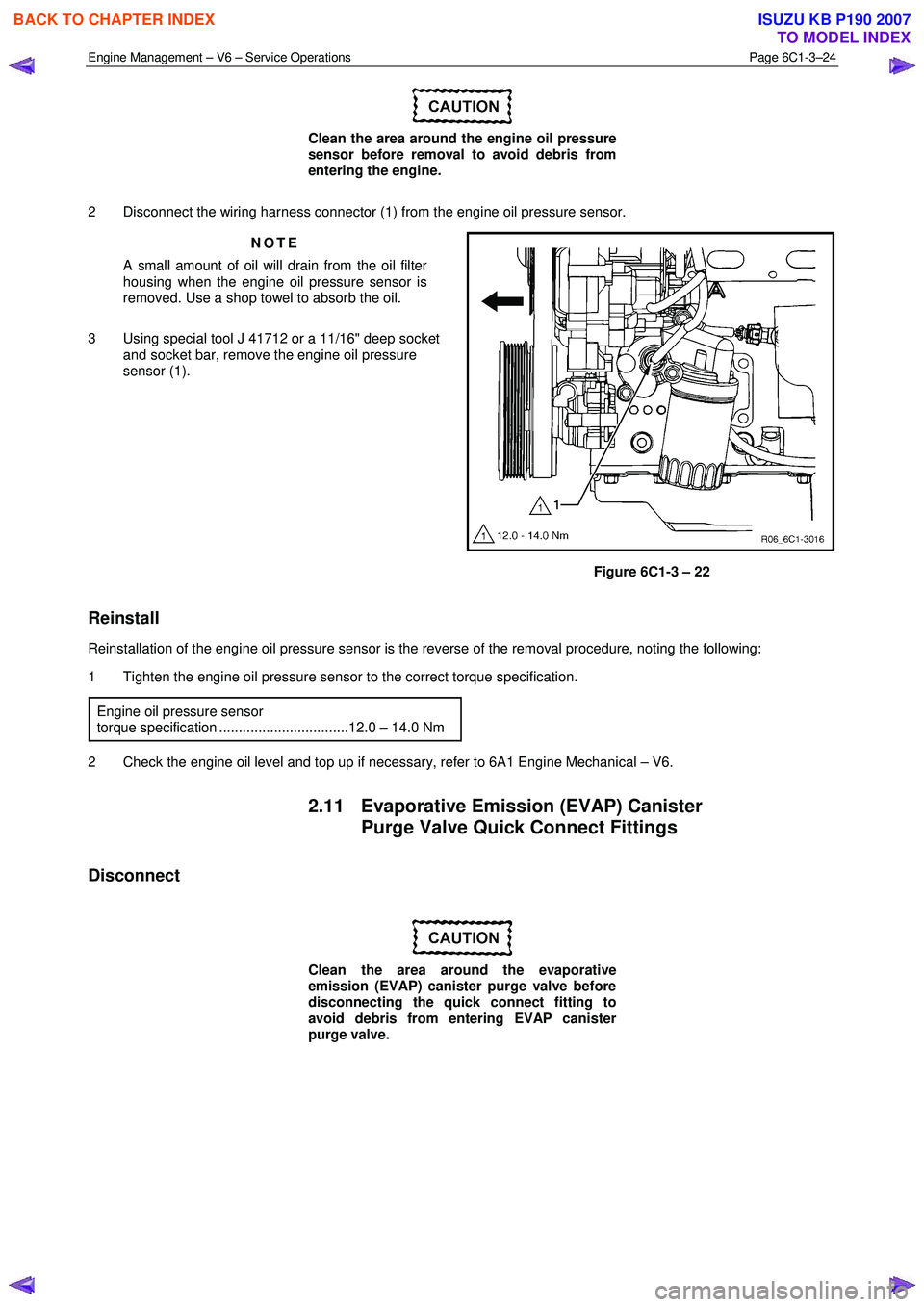
Engine Management – V6 – Service Operations Page 6C1-3–24
Clean the area around the engine oil pressure
sensor before removal to avoid debris from
entering the engine.
2 Disconnect the wiring harness connector (1) from the engine oil pressure sensor. NOTE
A small amount of oil will drain from the oil filter
housing when the engine oil pressure sensor is
removed. Use a shop towel to absorb the oil.
3 Using special tool J 41712 or a 11/16" deep socket and socket bar, remove the engine oil pressure
sensor (1).
Figure 6C1-3 – 22
Reinstall
Reinstallation of the engine oil pressure sensor is the reverse of the removal procedure, noting the following:
1 Tighten the engine oil pressure sensor to the correct torque specification.
Engine oil pressure sensor
torque specification .................................12.0 – 14.0 Nm
2 Check the engine oil level and top up if necessary, refer to 6A1 Engine Mechanical – V6.
2.11 Evaporative Emission (EVAP) Canister Purge Valve Quick Connect Fittings
Disconnect
Clean the area around the evaporative
emission (EVAP) canister purge valve before
disconnecting the quick connect fitting to
avoid debris from entering EVAP canister
purge valve.
BACK TO CHAPTER INDEX
TO MODEL INDEX
ISUZU KB P190 2007
Page 3549 of 6020
Engine Management – V6 – Service Operations Page 6C1-3–25
Locking Lever Type
1 Rotate the quick connect locking lever (1) in the
direction of the arrow.
2 W hilst holding the lever against its stop (2), pull the hose away from the EVAP canister purge valve.
Figure 6C1-3 – 23
Latch Type
1 Push the quick connect fitting (1) in the direction of
arrow.
2 W hilst pressing the two latches (2) in the direction of the arrows, pull the quick connect fitting (3) away from
the EVAP canister purge valve.
Figure 6C1-3 – 24
Connect
1 Lubricate the evaporative emission (EVAP) canister purge valve with clean engine oil.
Figure 6C1-3 – 25
BACK TO CHAPTER INDEX
TO MODEL INDEX
ISUZU KB P190 2007
Page 3550 of 6020
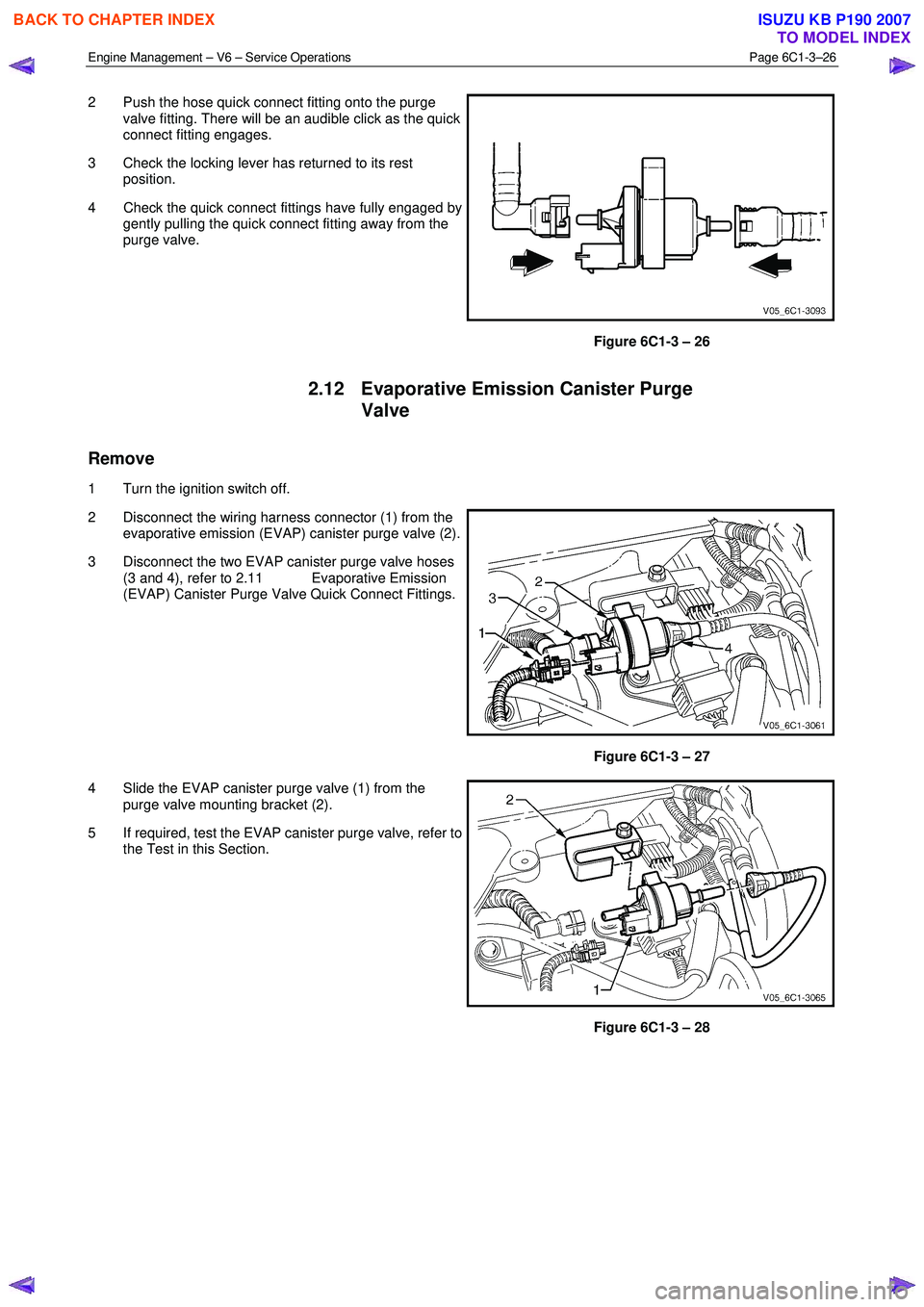
Engine Management – V6 – Service Operations Page 6C1-3–26
2 Push the hose quick connect fitting onto the purge
valve fitting. There will be an audible click as the quick
connect fitting engages.
3 Check the locking lever has returned to its rest position.
4 Check the quick connect fittings have fully engaged by gently pulling the quick connect fitting away from the
purge valve.
Figure 6C1-3 – 26
2.12 Evaporative Emission Canister Purge
Valve
Remove
1 Turn the ignition switch off.
2 Disconnect the wiring harness connector (1) from the evaporative emission (EVAP) canister purge valve (2).
3 Disconnect the two EVAP canister purge valve hoses (3 and 4), refer to 2.11 Evaporative Emission
(EVAP) Canister Purge Valve Quick Connect Fittings.
Figure 6C1-3 – 27
4 Slide the EVAP canister purge valve (1) from the purge valve mounting bracket (2).
5 If required, test the EVAP canister purge valve, refer to the Test in this Section.
Figure 6C1-3 – 28
BACK TO CHAPTER INDEX
TO MODEL INDEX
ISUZU KB P190 2007
Page 3551 of 6020
Engine Management – V6 – Service Operations Page 6C1-3–27
Test
To prevent component damage:
• Use connector test adaptor kit J 35616-A.
• When applying 12 V to a component,
always use a 3 A fused wire.
Resistance Check
1 Using a digital ohmmeter and connector test adaptor
kit J 35616-A, measure the resistance across
terminals 1 and 2.
2 Compare the reading against the specification.
3 If the resistance is not within specification, replace the EVAP canister purge valve.
EVAP canister purge valve
resistance @ 20°C .................................... 24.0 – 28.0 Ω
Figure 6C1-3 – 29
Functional Test
1 Attempt to blow air through the EVAP canister purge
valve inlet port (1). If air passes through the valve, the
valve is faulty and should be replaced.
Figure 6C1-3 – 30
BACK TO CHAPTER INDEX
TO MODEL INDEX
ISUZU KB P190 2007
Page 3552 of 6020
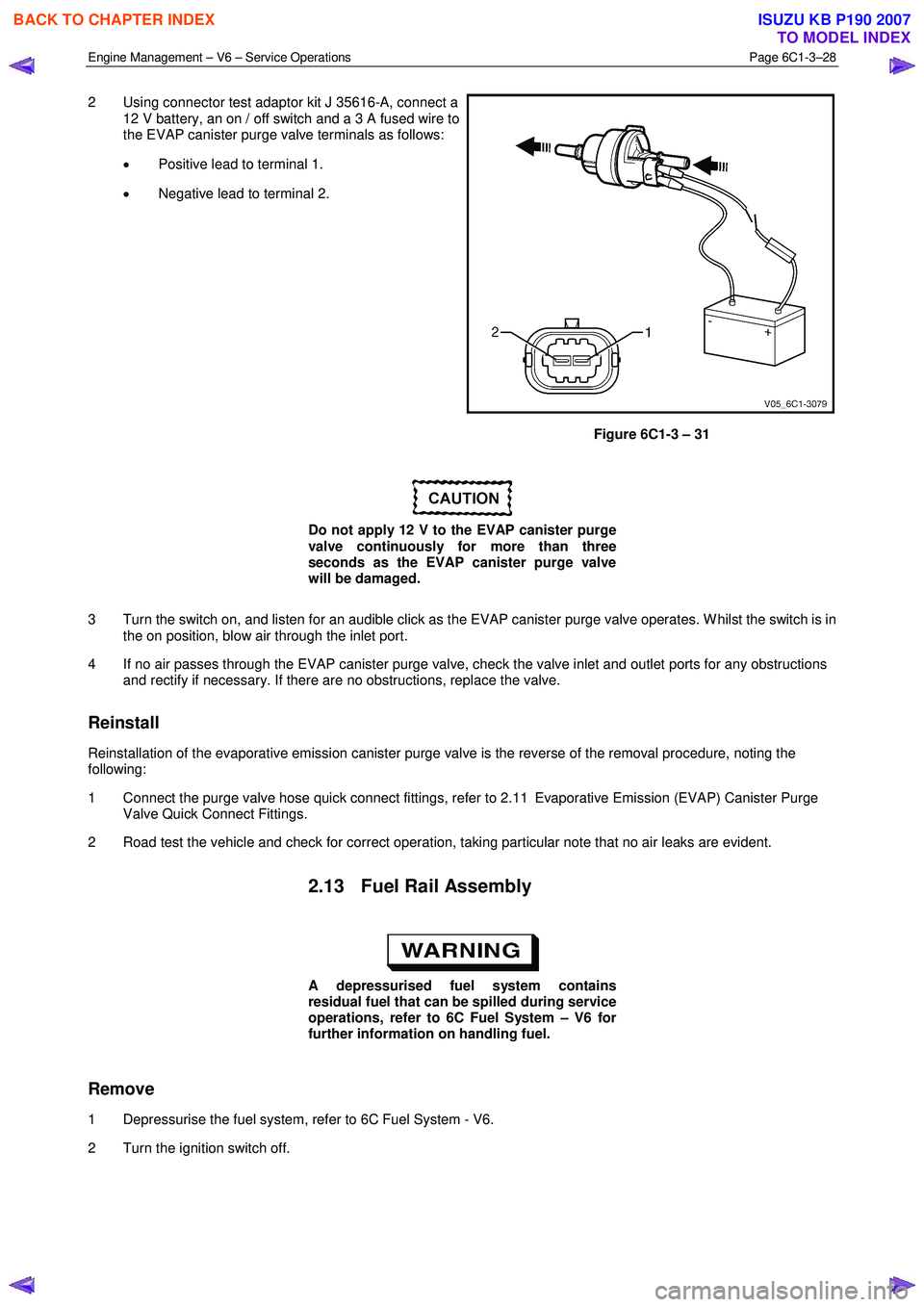
Engine Management – V6 – Service Operations Page 6C1-3–28
2 Using connector test adaptor kit J 35616-A, connect a
12 V battery, an on / off switch and a 3 A fused wire to
the EVAP canister purge valve terminals as follows:
• Positive lead to terminal 1.
• Negative lead to terminal 2.
Figure 6C1-3 – 31
Do not apply 12 V to the EVAP canister purge
valve continuously for more than three
seconds as the EVAP canister purge valve
will be damaged.
3 Turn the switch on, and listen for an audible click as the EVAP canister purge valve operates. W hilst the switch is in the on position, blow air through the inlet port.
4 If no air passes through the EVAP canister purge valve, check the valve inlet and outlet ports for any obstructions and rectify if necessary. If there are no obstructions, replace the valve.
Reinstall
Reinstallation of the evaporative emission canister purge valve is the reverse of the removal procedure, noting the
following:
1 Connect the purge valve hose quick connect fittings, refer to 2.11 Evaporative Emission (EVAP) Canister Purge Valve Quick Connect Fittings.
2 Road test the vehicle and check for correct operation, taking particular note that no air leaks are evident.
2.13 Fuel Rail Assembly
A depressurised fuel system contains
residual fuel that can be spilled during service
operations, refer to 6C Fuel System – V6 for
further information on handling fuel.
Remove
1 Depressurise the fuel system, refer to 6C Fuel System - V6.
2 Turn the ignition switch off.
BACK TO CHAPTER INDEX
TO MODEL INDEX
ISUZU KB P190 2007
Page 3553 of 6020
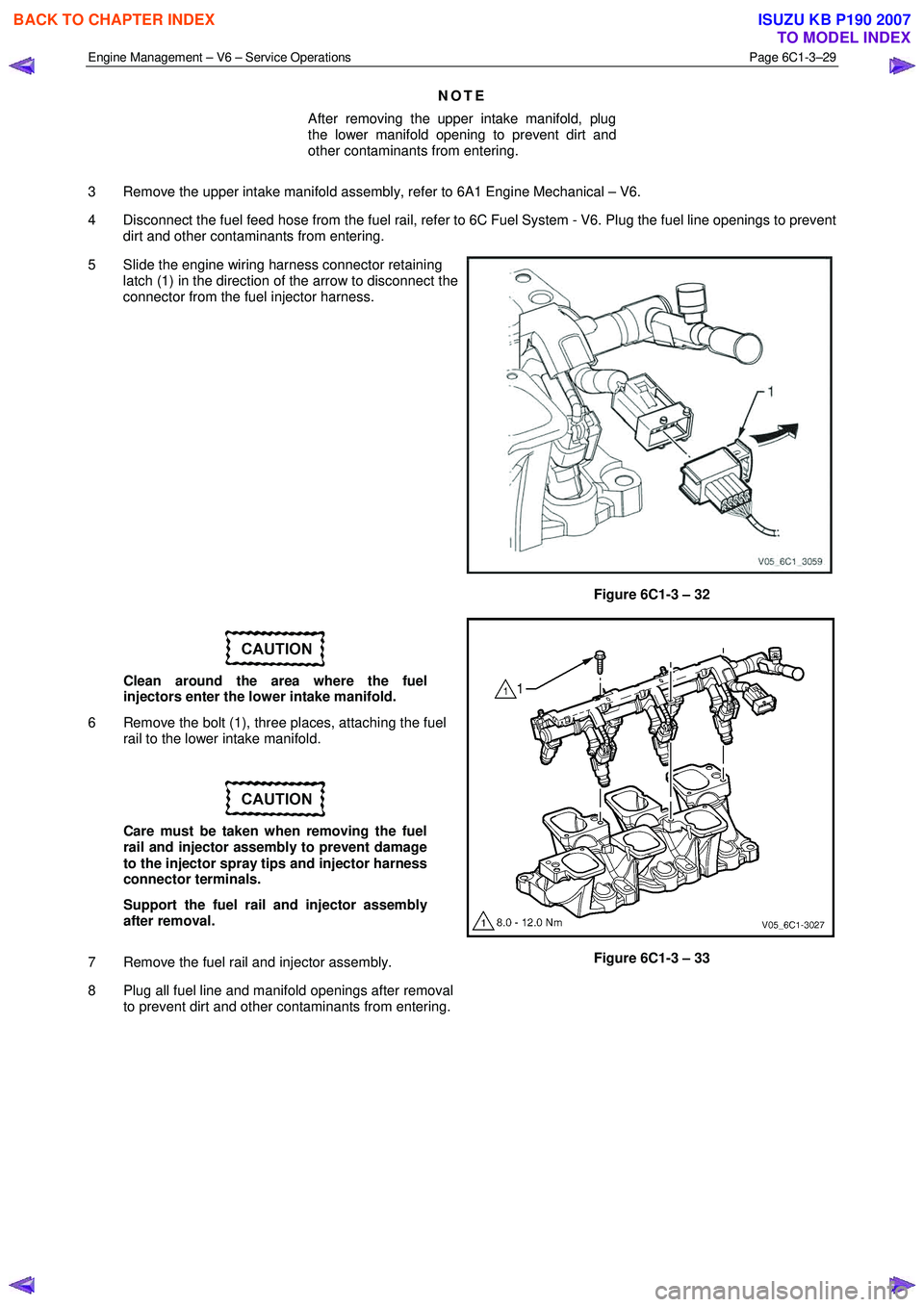
Engine Management – V6 – Service Operations Page 6C1-3–29
NOTE
After removing the upper intake manifold, plug
the lower manifold opening to prevent dirt and
other contaminants from entering.
3 Remove the upper intake manifold assembly, refer to 6A1 Engine Mechanical – V6.
4 Disconnect the fuel feed hose from the fuel rail, refer to 6C Fuel System - V6. Plug the fuel line openings to prevent dirt and other contaminants from entering.
5 Slide the engine wiring harness connector retaining latch (1) in the direction of the arrow to disconnect the
connector from the fuel injector harness.
Figure 6C1-3 – 32
Clean around the area where the fuel
injectors enter the lower intake manifold.
6 Remove the bolt (1), three places, attaching the fuel rail to the lower intake manifold.
Care must be taken when removing the fuel
rail and injector assembly to prevent damage
to the injector spray tips and injector harness
connector terminals.
Support the fuel rail and injector assembly
after removal.
7 Remove the fuel rail and injector assembly.
8 Plug all fuel line and manifold openings after removal to prevent dirt and other contaminants from entering.
Figure 6C1-3 – 33
BACK TO CHAPTER INDEX
TO MODEL INDEX
ISUZU KB P190 2007
Page 3554 of 6020
Engine Management – V6 – Service Operations Page 6C1-3–30
Disassemble
Fuel Injector
Remove
For each fuel injector:
1 Slide the fuel injector wiring connector locking tab (1) upwards in the direction of the arrow.
2 Disconnect the connector from the fuel injector.
Figure 6C1-3 – 34
3 Using a flat blade screwdriver, remove the fuel injector retaining clip (1) from the fuel injector (2). Discard the
retaining clip.
Figure 6C1-3 – 35
BACK TO CHAPTER INDEX
TO MODEL INDEX
ISUZU KB P190 2007
Page 3555 of 6020
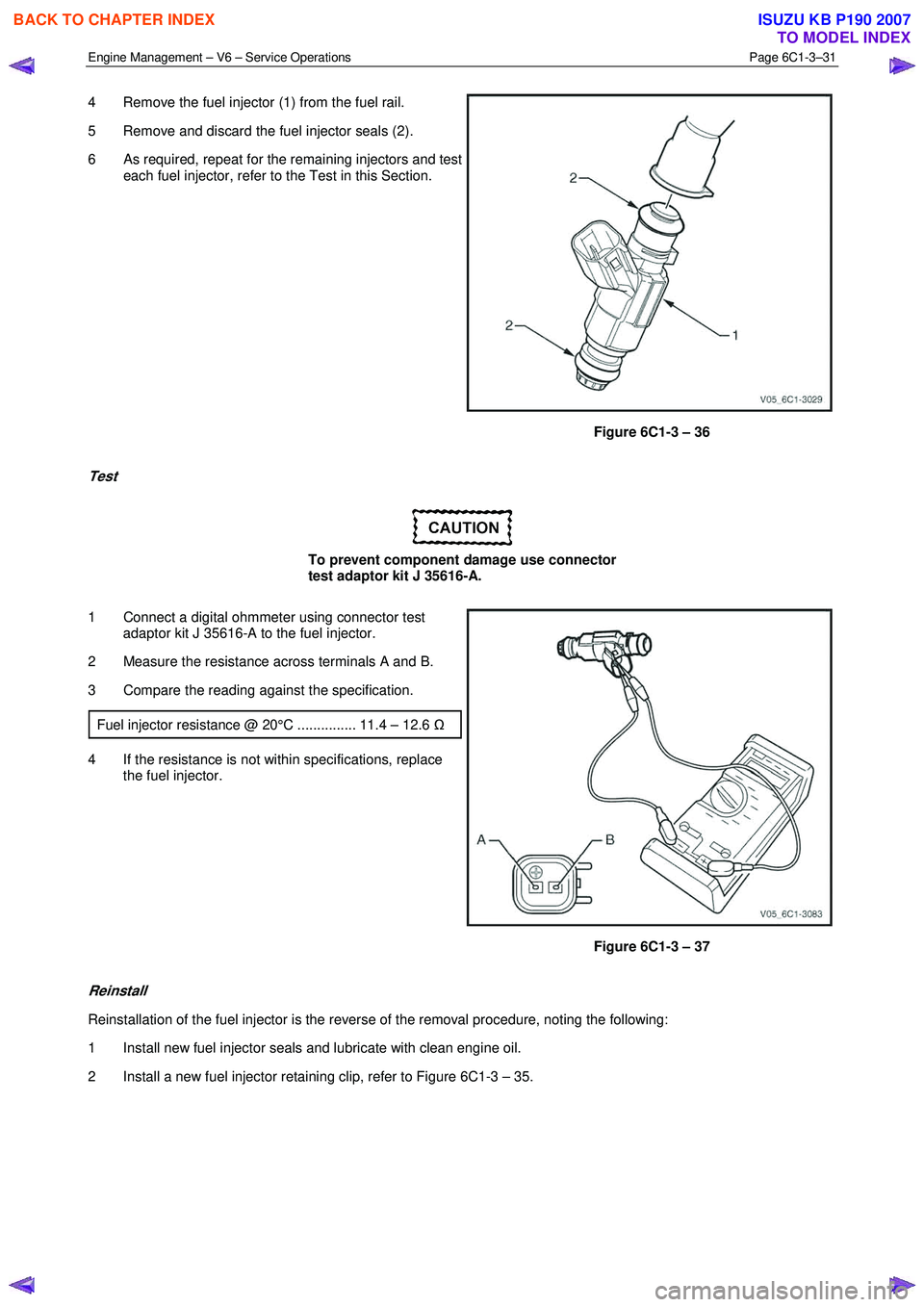
Engine Management – V6 – Service Operations Page 6C1-3–31
4 Remove the fuel injector (1) from the fuel rail.
5 Remove and discard the fuel injector seals (2).
6
As required, repeat for the remaining injectors and test
each fuel injector, refer to the Test in this Section.
Figure 6C1-3 – 36
Test
To prevent component damage use connector
test adaptor kit J 35616-A.
1 Connect a digital ohmmeter using connector test adaptor kit J 35616-A to the fuel injector.
2 Measure the resistance across terminals A and B.
3 Compare the reading against the specification.
Fuel injector resistance @ 20°C ............... 11.4 – 12.6 Ω
4 If the resistance is not within specifications, replace
the fuel injector.
Figure 6C1-3 – 37
Reinstall
Reinstallation of the fuel injector is the reverse of the removal procedure, noting the following:
1 Install new fuel injector seals and lubricate with clean engine oil.
2 Install a new fuel injector retaining clip, refer to Figure 6C1-3 – 35.
BACK TO CHAPTER INDEX
TO MODEL INDEX
ISUZU KB P190 2007